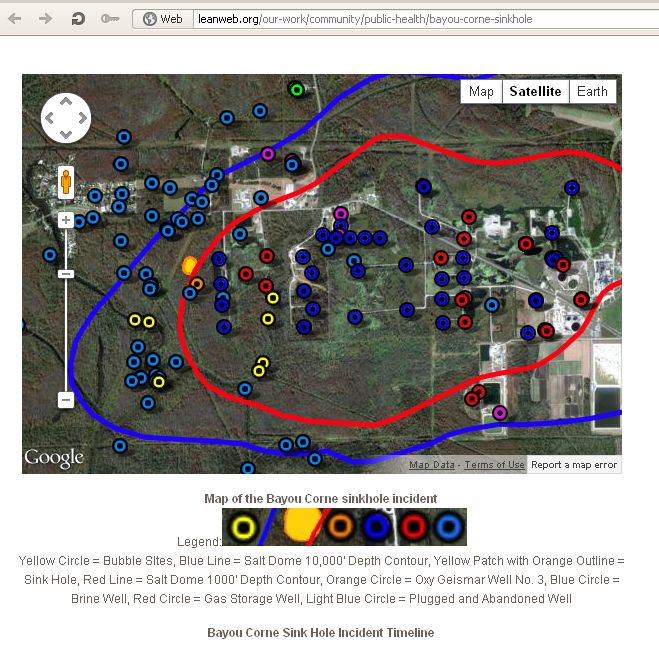Louisiana is dotted with salt domes (Avery Island is the most famous one). They are extensions of the massive Louann Formation that exists under much of the Gulf Coast. They can be bored out to make enormous caverns (most of the Strategic Petroleum Reserve [SPR] is salt dome storage). Because natural gas prices fluctuate so much, there are a variety of companies that operate caverns to store gas at low prices and sell it at high prices. DOE has a nice page on salt cavern storage.
The way it basically works is you drill a traditional well into the salt dome, with the bottom open. You have two areas: the center of the well and the annulus. You pump fresh water down one hole, it dissolves the salt, and saturated brine is returned up the other hole. The saturated brine is up to ~25% saline (seawater is only about 3% saline). By alternating which direction you pump (and also pumping in a little diesel here and there) you can actually control the size and shape of the cavity you create. The saturated brine can be injected into disposal wells or the salt can be separated and sold to industrial users (the diesel generally contaminates it for human consumption). If the salt dome is big enough, you can have multiple storage caverns in a single dome. Some of these individual caverns can be HUGE (size of the interior of the Superdome).
So, what can go wrong? Well, according to this book, about 30% of storage caverns are lost within the first 5 years of operation, primarily due to leaching the cavern too fast. Depending on the local geology, the subsidence may be barely noticeable spread over a large area, or massive sinkholes can form.
LA-DNR Sketch of Texas Brine cavern.
Texas Brine abandoned the cavern in questions, but then came back and tried to use the existing wellbore to make a second cavern. During the initial investigation on leaching a second cavern, issues started to develop ("Cavern Known to Have Problems"). A sinkhole formed nearby, gas and diesel started spilling into the wetlands, and now they've evacuated residents. One of these caverns can store a hole hell of a lot of gas. As long as the cavern stays full, it's actually very safe. Without oxygen, no fire/explosion can happen. It's once it starts to leak and you get a combustible air/fuel mixture that things get interesting. Depending on the leak rate, you could roast quite a few marshmallows.

Plan view of nearby areas of interest - via LEAN.
Plan view of nearby areas of interest - via LEAN.
One of the safety systems usually installed in these storage caverns is one ore more relief wells, pre-drilled. These relief wells don't serve the same function as the Macondo relief well did (pump mud/cement down to stop the problem). The relief well(s) are there to draw down the well as quickly as possible (generally going straight to a flare stack, burning up all the valuable product; imagine emptying a bank vault by setting the cash on fire). The goal is a controlled release instead of a uncontrolled relief.
The dangers of a cavern collapse aren't quite like Macondo. There's generally very little diesel (~10,000 gallons, max), but once the gas releases, you could have a vapour cloud, and there can be significant subsidence.
Here's the relief well plan for Bayou Corne:
Actual casing plan of the relief well in Bayou Corne cavern. Via LA-DNR.
Note that the relief well just had to stop drilling in order to case the well.
Interesting resources for anyone wanting to know more about the Bayou Corne Sinkhole:
* Times-Pic Overview article from Monday. I miss David Hammer's excellent reporting of Macondo. Too bad he left a sinking ship and was replaced by someone with 2 years experience.
* ABC's of the Sinkhole
* ABC's of the Sinkhole
"All this has happened before, and all this will happen again."
There are almost always historical parrallels for engineering disasters. Here's a few off the top of my head:
* Weeks Island, LA, SPR The only SPR cavern that WASN'T a leached salt dome collapsed. SPR had to sell off a massive amount of inventory very quickly and spent a while cleaning it up. Fortunately, they just sold more oil and nobody really noticed. Since then, the Feds have had PhD's cranking out paper after paper on salt tectonics to make sure they never lose another SPR cavern.
* Lake Peigneur disaster:
The Iberia Parish Sheriff called the disaster, "The Coonass Mount Saint Helens" to the assembled throng of national media. No fatalities, amazingly. What was a ~6' deep freshwater lake became a several-hundred foot deep saltwater lake with excellent fishing (or so I'm informed). There's also 2 barges that have never been accounted for.
UPDATE- Minor formatting glitches fixed.
No comments:
Post a Comment